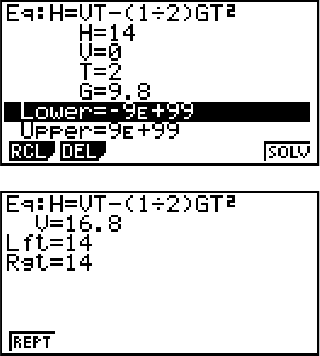
4-4
3. Solve Calculations
The Solve Calculation mode lets you determine the value of any variable in a formula without
having to solve the equation.
1. From the Main Menu, enter the EQUA mode.
2. Select the SOLV (Solver) mode, and input the equation as it is written.
• If you do not input an equals sign, the calculator assumes that the expression is to the left
of the equals sign, and there is a zero to the right.
• An error occurs if you input more than one equals sign.
3. In the table of variables that appears on the display, input values for each variable.
• You can also specify values for Upper and Lower to define the upper and lower limits of
the range of solutions.
• An error occurs if the solution falls outside the range you specify.
4. Select the variable for which you want to solve to obtain the solution.
“Lft” and “Rgt” indicate the left and right sides that are calculated using the solution.*
1
*
1
Solutions are approximated using Newton’s method. Lft and Rgt values are displayed for
confirmation, because Newton’s method may produce results that are the real solution.
The closer the difference between the Lft and Rgt values is to zero, the lower degree of
error in the result.
Example An object thrown into the air at initial velocity V takes time T to reach
height H. Use the following formula to solve for initial velocity V when
H = 14 (meters), T = 2 (seconds) and gravitational acceleration is G =
9.8 (m/s
2
).
H = VT – 1/2 GT
2
K EQUA
(SOLV)
?,(H)(=)?A(V)?(T)\
@A?(G)?(T)VU
@CU(H = 14)
?U(V = 0)
AU(T = 2)
HGU(G = 9.8)
Press DDD to highlight V = 0, and then press
(SOLV).
• The message “Retry” appears on the display when the calculator judges that convergence is
not sufficient for the displayed results.
• A Solve operation will produce a single solution. Use POLY when you want to obtain multiple
solutions for a high-order equation (such as ax
2
+ bx + c = 0).


















